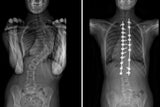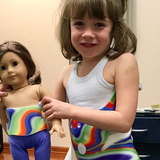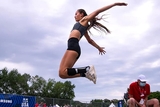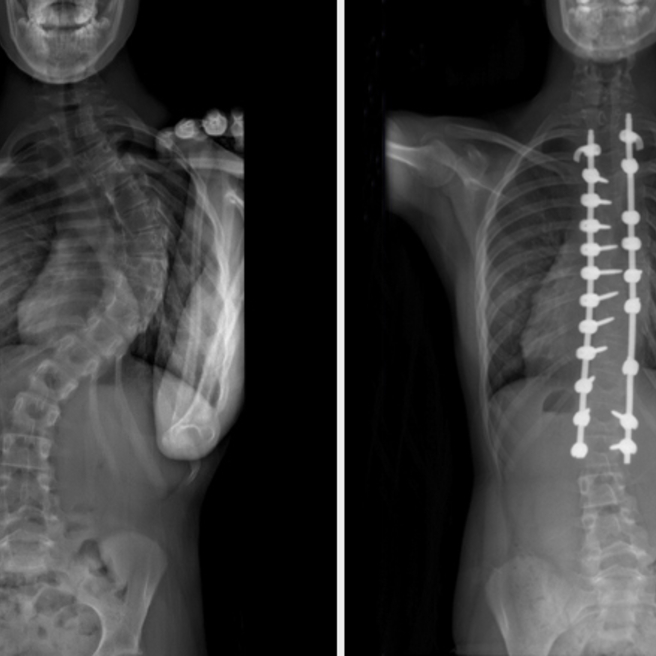
If your child has a spine that curves sideways in the shape of an “S” or “C” (instead of an “I”) they may have scoliosis. While scoliosis can sometimes run in families, most cases in children are idiopathic, meaning the exact cause is unknown. Because a person can’t “feel” that they have mild or moderate scoliosis, many people have it and don’t even know. But despite common misconceptions, scoliosis is not caused by anything in your child’s or your family’s lifestyle.
Scoliosis can appear in babies or in early childhood, but it most often develops between ages 10-18, when rapid growth spurts can cause curves in the spine to progress. While boys and girls are diagnosed at similar rates, girls are more likely to develop larger curves that require treatment. Fortunately, advancements in care have made it easier than ever to manage scoliosis effectively.
Early diagnosis is key—when scoliosis is caught and treated in its early stages, there’s a strong chance of stopping the curve’s progression and avoiding surgery. Let's cover 10 essential facts you need to know as a parent or caregiver to ensure your child receives the best possible care.
1. Scoliosis is common
Scoliosis is one of the most common spinal deformities. This condition affects 2-3% of the U.S. population. This equates to about three in every 100 Americans, or an estimated 6-9 million people.
Your child may have been born with scoliosis (congenital scoliosis), they may develop it later in childhood (idiopathic scoliosis) or it may have been caused by other conditions like cerebral palsy and spina bifida (neuromuscular scoliosis). Idiopathic scoliosis is the most common type in the world.
If your child has been diagnosed with scoliosis, it may be reassuring to know that while there is no cure, it can be very effectively managed. With early detection and proper treatment, most children with scoliosis can live active, healthy lives without any significant limitations.
Advances in bracing techniques and non-surgical treatments are helping to slow or even stop the progression of spinal curves, reducing the odds that your child will ever need surgery. With ongoing research and improved treatment options, scoliosis care continues to evolve, offering hope and better outcomes for children and their families.
2. The causes of scoliosis are mostly unknown
While idiopathic scoliosis has no clear cause, extensive research, including studies conducted here at Children’s Hospital of Philadelphia (CHOP), has shown that genetics play a role, and scoliosis can run in families. There is a 30% chance of developing it if a close relative has the condition.
Scoliosis is driven by uneven (asymmetric) growth of the spine—the front of spine (the anterior) grows faster than the back. This asymmetric growth causes the spine to curve and turn inward (lordosis). Because scoliosis is related directly to growth, this makes the rapid puberty growth spurt a high-risk time for the curve to become rapidly worse.
Scoliosis is not caused by external factors like poor posture, carrying heavy backpacks or playing sports. In many cases, it develops gradually, with early symptoms that can be difficult to detect. As a parent or caregiver, you should look for subtle signs in your child, like uneven shoulders, a shoulder blade sticking out, one hip appearing more pronounced or clothing hanging unevenly on their body.
Scoliosis affects both boys and girls, but research shows that girls are significantly more at risk for significant progression. Girls are also eight times more likely to experience a worsening spinal curvature, increasing the likelihood that they will need treatment. Because of this higher risk, regular screenings and early intervention are especially important for girls to prevent progression and reduce the need for more invasive treatments like surgery.
3. Adolescent idiopathic scoliosis starts just before puberty
Adolescent idiopathic scoliosis is typically detected between ages 10-18, during a child’s peak growth years. Because scoliosis often develops gradually and without pain, regular screenings are essential for early detection. Children usually have their spines checked as part of their annual physical with their pediatrician and, in many cases, by a school nurse as well. These routine exams help identify any signs of abnormal curvature early, allowing for timely intervention before the condition progresses.
If your child is diagnosed with scoliosis and the curve is mild, your doctor will likely recommend checkups every 4-5 months to monitor any changes in the position of your child’s spine.
4. See a specialist if you notice a difference in the sides of your child’s body
Early detection of idiopathic scoliosis is vital for us to effectively manage your child’s spinal curves and keep them from progressing. If you, a nurse or your pediatrician notice any differences in the sides of your child’s body (asymmetry) in their shoulders, shoulder blades, spine or pelvis, it’s important to have them evaluated by a specialist.
Common signs of scoliosis include:
- Uneven shoulder or hip height
- A head that isn’t centered with the body
- One shoulder blade sticking out more than the other
- Most importantly, when bending forward, one side of your child’s back may also appear higher than the other (this is the screening test pediatricians use)
If you or your pediatrician suspect your child could have scoliosis, a pediatric spine specialist can perform an X-ray to confirm the diagnosis and measure the degree of curvature. Catching scoliosis early allows for timely intervention, which can help manage the condition effectively and reduce the likelihood of your child needing surgery in the future.
At CHOP, children with suspected scoliosis are evaluated by expert pediatric orthopedic physicians in our Spine Program who specialize in spinal conditions. These specialists will conduct a thorough medical history, a comprehensive physical examination and a visual assessment of your child’s spinal curvature. Our dedicated spinal team is experienced in diagnosing and treating all forms of scoliosis and providing access to advanced treatment options including bracing, physical therapy and innovative exercise programs designed to slow curve progression.
5. Early diagnosis is key
Early diagnosis is key when it comes to scoliosis. Timely intervention can help prevent the need for surgery. In cases where a growing child’s spinal curve is 25 degrees, the bracing is started. Medical advances in recent years, especially here at CHOP, have provided children with more treatment options than ever before. Modern, custom-made braces that fit the body’s shape in all directions (three-dimensional) have been shown to stop the curve from getting worse in 95% of cases. With the use of advanced imaging techniques, including X-rays that use minimal radiation, and more precise bracing methods, treatment can begin earlier and lead to better long-term outcomes.
When scoliosis is detected early, the likelihood of needing surgery decreases significantly, and children are more likely to live healthy, active lives. But early detection is still a challenge, since less than half of U.S. states require scoliosis screening in schools. If left undiagnosed, severe scoliosis can lead to chronic back pain and even interfere with heart and lung function. It is important for parents, teachers and healthcare providers to learn to recognize the signs of scoliosis so they can ensure timely diagnosis and treatment for children who need it. The sooner scoliosis is addressed, the better the chances for successful management and avoiding more invasive procedures.
6. Your child should wear the brace as recommended
Properly wearing a brace as instructed by a scoliosis specialist will ensure the best possible outcome for your child. Braces are custom designed in three dimensions (height, width and depth) for your child to provide the necessary curve correction for their specific curve. When your child’s spine requires bracing, it’s essential to discuss the most effective option with your scoliosis doctor, who will choose a brace that your child is most likely to wear as prescribed. In many cases, the recommended wear time is 17 hours a day during the fastest phase of growth. The brace is then weaned down progressively to nighttime only near the end of growth. When growth is complete, bracing stops. Wearing the brace for the full amount of time recommended each day is essential. Many children who wear the braces as recommended complete treatment with a curve smaller and more harmless than when they started.
Advancements in bracing technology have made braces more comfortable and less noticeable than ever before. Unlike older, bulkier braces, modern options are often lightweight and discreet. This can make them easier for your child to wear without feeling self-conscious. Although it may feel uncomfortable at first, most children adjust to the brace quickly.
During the bracing process, CHOP doctors will continue to monitor your child’s progress. To get a true picture of how their scoliosis is progressing, we ask that the brace be removed two days before an X-ray. This gives their spine time to return to its natural shape, so the results aren’t affected by the brace.
Featured in this article
Specialties & Programs
If your child has a spine that curves sideways in the shape of an “S” or “C” (instead of an “I”) they may have scoliosis. While scoliosis can sometimes run in families, most cases in children are idiopathic, meaning the exact cause is unknown. Because a person can’t “feel” that they have mild or moderate scoliosis, many people have it and don’t even know. But despite common misconceptions, scoliosis is not caused by anything in your child’s or your family’s lifestyle.
Scoliosis can appear in babies or in early childhood, but it most often develops between ages 10-18, when rapid growth spurts can cause curves in the spine to progress. While boys and girls are diagnosed at similar rates, girls are more likely to develop larger curves that require treatment. Fortunately, advancements in care have made it easier than ever to manage scoliosis effectively.
Early diagnosis is key—when scoliosis is caught and treated in its early stages, there’s a strong chance of stopping the curve’s progression and avoiding surgery. Let's cover 10 essential facts you need to know as a parent or caregiver to ensure your child receives the best possible care.
1. Scoliosis is common
Scoliosis is one of the most common spinal deformities. This condition affects 2-3% of the U.S. population. This equates to about three in every 100 Americans, or an estimated 6-9 million people.
Your child may have been born with scoliosis (congenital scoliosis), they may develop it later in childhood (idiopathic scoliosis) or it may have been caused by other conditions like cerebral palsy and spina bifida (neuromuscular scoliosis). Idiopathic scoliosis is the most common type in the world.
If your child has been diagnosed with scoliosis, it may be reassuring to know that while there is no cure, it can be very effectively managed. With early detection and proper treatment, most children with scoliosis can live active, healthy lives without any significant limitations.
Advances in bracing techniques and non-surgical treatments are helping to slow or even stop the progression of spinal curves, reducing the odds that your child will ever need surgery. With ongoing research and improved treatment options, scoliosis care continues to evolve, offering hope and better outcomes for children and their families.
2. The causes of scoliosis are mostly unknown
While idiopathic scoliosis has no clear cause, extensive research, including studies conducted here at Children’s Hospital of Philadelphia (CHOP), has shown that genetics play a role, and scoliosis can run in families. There is a 30% chance of developing it if a close relative has the condition.
Scoliosis is driven by uneven (asymmetric) growth of the spine—the front of spine (the anterior) grows faster than the back. This asymmetric growth causes the spine to curve and turn inward (lordosis). Because scoliosis is related directly to growth, this makes the rapid puberty growth spurt a high-risk time for the curve to become rapidly worse.
Scoliosis is not caused by external factors like poor posture, carrying heavy backpacks or playing sports. In many cases, it develops gradually, with early symptoms that can be difficult to detect. As a parent or caregiver, you should look for subtle signs in your child, like uneven shoulders, a shoulder blade sticking out, one hip appearing more pronounced or clothing hanging unevenly on their body.
Scoliosis affects both boys and girls, but research shows that girls are significantly more at risk for significant progression. Girls are also eight times more likely to experience a worsening spinal curvature, increasing the likelihood that they will need treatment. Because of this higher risk, regular screenings and early intervention are especially important for girls to prevent progression and reduce the need for more invasive treatments like surgery.
3. Adolescent idiopathic scoliosis starts just before puberty
Adolescent idiopathic scoliosis is typically detected between ages 10-18, during a child’s peak growth years. Because scoliosis often develops gradually and without pain, regular screenings are essential for early detection. Children usually have their spines checked as part of their annual physical with their pediatrician and, in many cases, by a school nurse as well. These routine exams help identify any signs of abnormal curvature early, allowing for timely intervention before the condition progresses.
If your child is diagnosed with scoliosis and the curve is mild, your doctor will likely recommend checkups every 4-5 months to monitor any changes in the position of your child’s spine.
4. See a specialist if you notice a difference in the sides of your child’s body
Early detection of idiopathic scoliosis is vital for us to effectively manage your child’s spinal curves and keep them from progressing. If you, a nurse or your pediatrician notice any differences in the sides of your child’s body (asymmetry) in their shoulders, shoulder blades, spine or pelvis, it’s important to have them evaluated by a specialist.
Common signs of scoliosis include:
- Uneven shoulder or hip height
- A head that isn’t centered with the body
- One shoulder blade sticking out more than the other
- Most importantly, when bending forward, one side of your child’s back may also appear higher than the other (this is the screening test pediatricians use)
If you or your pediatrician suspect your child could have scoliosis, a pediatric spine specialist can perform an X-ray to confirm the diagnosis and measure the degree of curvature. Catching scoliosis early allows for timely intervention, which can help manage the condition effectively and reduce the likelihood of your child needing surgery in the future.
At CHOP, children with suspected scoliosis are evaluated by expert pediatric orthopedic physicians in our Spine Program who specialize in spinal conditions. These specialists will conduct a thorough medical history, a comprehensive physical examination and a visual assessment of your child’s spinal curvature. Our dedicated spinal team is experienced in diagnosing and treating all forms of scoliosis and providing access to advanced treatment options including bracing, physical therapy and innovative exercise programs designed to slow curve progression.
5. Early diagnosis is key
Early diagnosis is key when it comes to scoliosis. Timely intervention can help prevent the need for surgery. In cases where a growing child’s spinal curve is 25 degrees, the bracing is started. Medical advances in recent years, especially here at CHOP, have provided children with more treatment options than ever before. Modern, custom-made braces that fit the body’s shape in all directions (three-dimensional) have been shown to stop the curve from getting worse in 95% of cases. With the use of advanced imaging techniques, including X-rays that use minimal radiation, and more precise bracing methods, treatment can begin earlier and lead to better long-term outcomes.
When scoliosis is detected early, the likelihood of needing surgery decreases significantly, and children are more likely to live healthy, active lives. But early detection is still a challenge, since less than half of U.S. states require scoliosis screening in schools. If left undiagnosed, severe scoliosis can lead to chronic back pain and even interfere with heart and lung function. It is important for parents, teachers and healthcare providers to learn to recognize the signs of scoliosis so they can ensure timely diagnosis and treatment for children who need it. The sooner scoliosis is addressed, the better the chances for successful management and avoiding more invasive procedures.
6. Your child should wear the brace as recommended
Properly wearing a brace as instructed by a scoliosis specialist will ensure the best possible outcome for your child. Braces are custom designed in three dimensions (height, width and depth) for your child to provide the necessary curve correction for their specific curve. When your child’s spine requires bracing, it’s essential to discuss the most effective option with your scoliosis doctor, who will choose a brace that your child is most likely to wear as prescribed. In many cases, the recommended wear time is 17 hours a day during the fastest phase of growth. The brace is then weaned down progressively to nighttime only near the end of growth. When growth is complete, bracing stops. Wearing the brace for the full amount of time recommended each day is essential. Many children who wear the braces as recommended complete treatment with a curve smaller and more harmless than when they started.
Advancements in bracing technology have made braces more comfortable and less noticeable than ever before. Unlike older, bulkier braces, modern options are often lightweight and discreet. This can make them easier for your child to wear without feeling self-conscious. Although it may feel uncomfortable at first, most children adjust to the brace quickly.
During the bracing process, CHOP doctors will continue to monitor your child’s progress. To get a true picture of how their scoliosis is progressing, we ask that the brace be removed two days before an X-ray. This gives their spine time to return to its natural shape, so the results aren’t affected by the brace.

Bracing helped reverse Emma’s scoliosis
A routine X-ray led to Emma’s scoliosis diagnosis at just four years old. Thanks to expert care at CHOP and her dedication to bracing, she achieved an outcome so rare, even her doctors were amazed.
7. Physical therapy and targeted exercises can help with scoliosis
Physical therapy has been shown to make bracing more comfortable and successful, reducing the likelihood your child will need surgery. The type of treatment your child receives will depend on their age, as well as the size and location of the curve in their spine. Therapy alone has not been shown to stop the progression of scoliosis or take away the need for bracing.
Physical therapy for scoliosis focuses on strengthening your child’s core muscles, improving their posture and retraining their body’s movement patterns to support a more aligned spine. Our physical therapists teach specific exercises and corrective breathing techniques that help develop the inner muscles of the rib cage, reshape the upper trunk and work to counteract the spinal curve. By committing to a structured physical therapy program, your child with scoliosis may be able to maintain flexibility, reduce discomfort and manage their condition effectively—without surgery.
8. Surgery is usually necessary for a spine curve of 50 degrees or more
For more severe cases of scoliosis, particularly when the spinal curve reaches 50 degrees or more, surgery is typically necessary to prevent further progression and improve spinal alignment. The type of surgical intervention your child may need depends on their age, stage of growth and the severity of their spinal curve. Potential advanced surgical options might include:
- Growing rods - Growth friendly implants are needed for very young children (toddlers or elementary school age) who have severe scoliosis and bracing or casting has failed or cannot be used. Often multiple surgeries are needed. Some implants can be adjusted noninvasively using magnets, reducing the number of surgeries.
- Vertebral body tethering (VBT) - A motion-preserving procedure appropriate for a small group of rapidly growing older children (near puberty) who have certain curve patterns. VBT uses screws and flexible cords to guide spinal growth and slow curve progression. The technology is new, and failure rates are still very high. Experts currently estimate VBT as the best treatment method for less than 5% of all scoliosis in growing children that requires surgery. This is still an experimental technique being studied in nationwide trials.
- Pediatric spinal fusion surgery Spine correction with fusion is the standard of care for most adolescents with a scoliosis curve greater than 50 degrees. With modern implants and techniques, results have become consistently excellent. In more than 95% of cases, the curve is corrected, and patients return to all their preferred activities (including competitive sports, gymnastics and dancing, etc.) just a few months after surgery. In these cases, no other procedure is needed for scoliosis for the rest of the patient’s life. Long range studies now show consistently great outcomes late into life.
- Spinal fusion for neuromuscular scoliosis - Designed for children with scoliosis caused by conditions like cerebral palsy or muscular dystrophy, this procedure fuses bones in the spine with bone taken locally from the spine. Metal rods provide stability while the spine heals into a single, straighter structure, offering a permanent solution that rarely requires repeat procedures.
9. If left untreated, scoliosis can worsen or lead to additional complications
While scoliosis is often viewed as a spinal condition that affects posture and appearance, it is not just a cosmetic issue. If left untreated, scoliosis can worsen over time, potentially leading to serious health complications. When spinal curves reach 70 degrees or more, lung function can become impaired, making it difficult for your child to breathe properly. At 90 degrees or more, both your child’s lung and heart function can be affected, increasing the risk of long-term breathing and heart issues.
In the most severe cases, scoliosis can contribute to thoracic insufficiency syndrome (TIS), a condition where chest wall deformities prevent normal lung growth and function. This condition is usually first detected very early in life, often in children with congenital spinal disorders and can cause breathing difficulties or even relying on ventilator support. And we can help. Our Wyss/Campbell Center for Thoracic Insufficiency Syndrome here at CHOP was the first to identify TIS as a disease requiring specialized care. CHOP experts also pioneered the vertical expandable prosthetic titanium rib (VEPTR), the first FDA-approved device designed to treat TIS and help children with severe spinal and rib deformities breathe more easily as they grow.
10. Remember, scoliosis is treatable!
We know that as a parent, a scoliosis diagnosis can feel overwhelming. But it’s important to know that this condition is highly treatable, and with proper care your child can go on to live a full, active life. Even if your child requires surgery, advancements in treatment have greatly improved outcomes, and can allow your child to return to their favorite activities, including things like sports, gymnastics and dance. With early detection and expert care, many children with scoliosis show no visible signs of the condition within a few years of treatment and can pursue any career or lifestyle they choose without limitation.
If your child has more complex scoliosis, like neuromuscular scoliosis, successful spinal surgery and post-operative care can significantly improve their quality of life. A straighter spine can enhance their breathing, reduce respiratory risks and promote better posture and mobility. Here at CHOP, our specialists will work closely with your family to ensure the best possible outcomes, giving your child the opportunity to grow, thrive and engage in the activities they love.

Scoliosis success stories
Many scoliosis patients treated at CHOP have achieved remarkable results, getting back to the activities they love with stronger, healthier spines.
Frequently asked questions about scoliosis
Are children born with scoliosis or does it develop?
Scoliosis can be present at birth (congenital scoliosis) or develop later in childhood or adolescence. The most common type, adolescent idiopathic scoliosis, usually starts between ages 10-18 when the spine grows unevenly during puberty causing the curve to worsen during growth. Research suggests it may run in families (a genetic component). Other forms may be linked to neuromuscular conditions, environmental factors or other spinal abnormalities.
At what age is scoliosis usually diagnosed?
Scoliosis is most diagnosed between ages 10-15, during peak growth spurts in adolescence (idiopathic scoliosis). However, it can also be detected in infancy or early childhood (early onset scoliosis) in some cases. Regular spine checks during annual pediatrician visits or school screenings can help identify scoliosis early for timely intervention.
Does childhood scoliosis go away?
Childhood scoliosis typically does not go away on its own, but in some cases, mild curves may stabilize as your child grows. Treatments like bracing or surgery may be necessary depending on the severity and progression of the curve. Early detection and regular monitoring are essential to managing your child’s condition effectively.
What can worsen scoliosis?
Scoliosis can worsen due to factors like rapid growth during puberty, which can increase the curvature of your child’s spine. Additionally, certain conditions like neuromuscular disorders or spinal injuries may also contribute to the progression of scoliosis. Early prevention and regular monitoring are important to prevent worsening.
At what age is it too late to treat scoliosis?
There is no specific age when it becomes "too late" to treat scoliosis, but treatment options become more limited once a person reaches skeletal maturity. Early detection and intervention during growth spurts, however, offer the best chance for effective treatment. Our Spine Program can work with you to determine the best treatment options for your child.
Recommended reading
Right Treatment, Right Time

CHOP explores alternatives to posterior spinal fusion for adolescent idiopathic scoliosis.
Scoliosis: Early Detection Matters

When scoliosis treatment is delayed, spine curvature can advance and make treatment more challenging.
Contact us
Spine Program